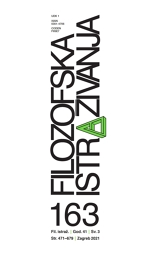Postmoderno napuštanje hilemorfizma u konceptualističkoj estetici Arthura Colemana Dantoa
Postmodern Abandonment of Hylemorphism in Arthur Coleman Danto’s Conceptualist Aesthetics
Author(s): Goran SunajkoSubject(s): Visual Arts, Aesthetics, Structuralism and Post-Structuralism, Phenomenology, Sociology of Art
Published by: Hrvatsko Filozofsko Društvo
Keywords: aesthetics; aesthetic distance; aesthetic object; conceptual art; form; shape; Andy Warhol; Arthur Coleman Danto;
Summary/Abstract: The paper considers the philosophical relationship between the form (idea) and the shape (figure) through the meaning of conceptualist art, which Arthur Coleman Danto emphasizes in his aesthetic theory. Even though modern art from the beginning of the 20th century signalled the break between the form and the shape, it has fully come to life in the postmodern sense. It will be shown that conceptual artists have understood how it is possible to keep the shape of a thing without changing its form, with the idea displacing it from a predetermined function. For conceptual, postmodern art, it will be decisive to keep the shape while changing the form in which such a work of art is created, changing the character of things that were not a work of art until then. According to Hartmann’s aesthetic theory, this creates a unique aesthetic object that does not rest on the work of art itself but its perception. Danto exemplified such a path with Duchamp’s Fountain and Warhol’s Brillo Box, which witnessed a change of the form while retaining the shape, establishing postmodern aesthetics as essentially conceptual.
Journal: Filozofska istraživanja
- Issue Year: 41/2021
- Issue No: 03/163
- Page Range: 565-578
- Page Count: 14
- Language: Croatian

